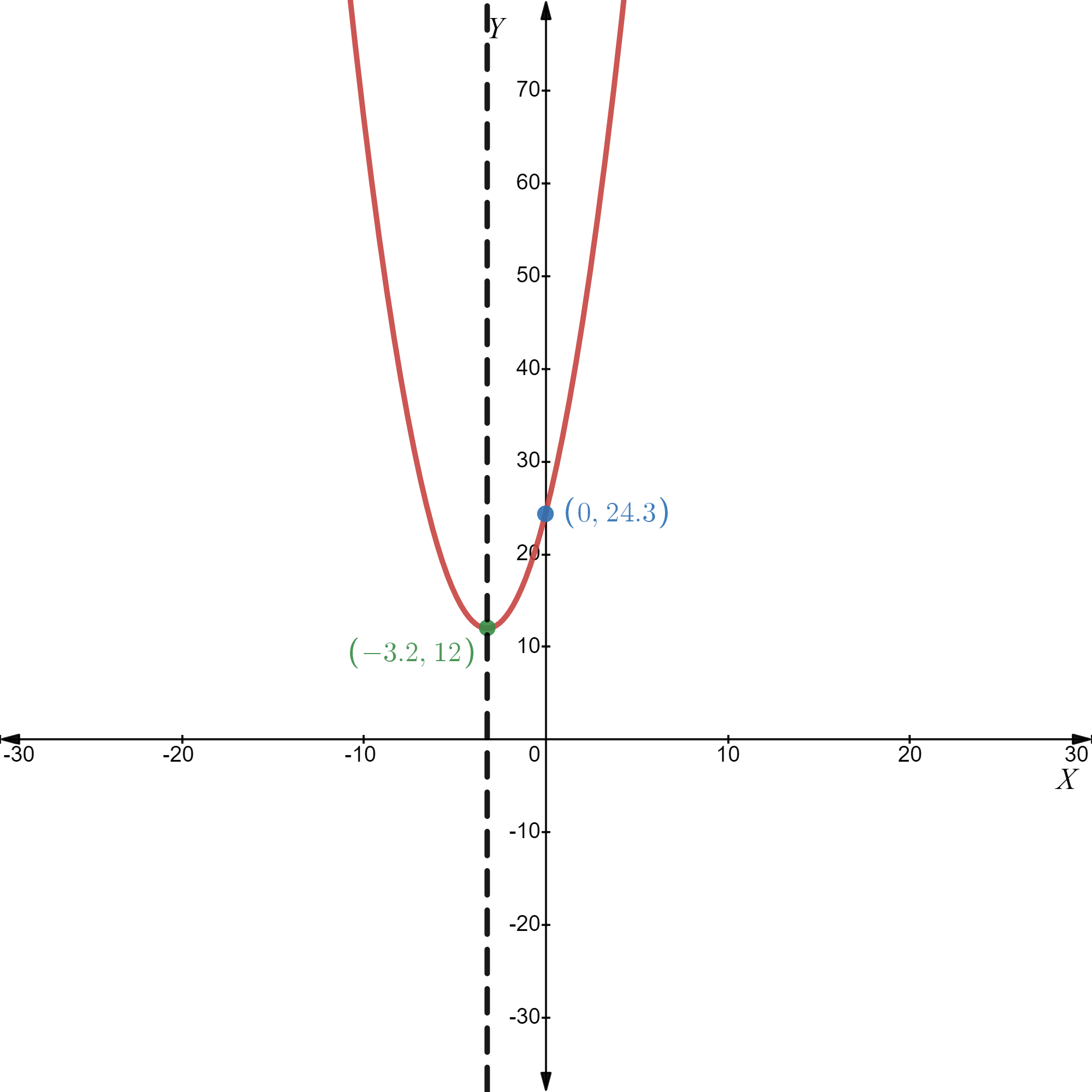Pre-Calculus 11 Student Edition Chapter 3 Quadratic Functions
Page 164 Problem 1 Answer
The three possible paths for football will look like

The three possible paths for football will look like
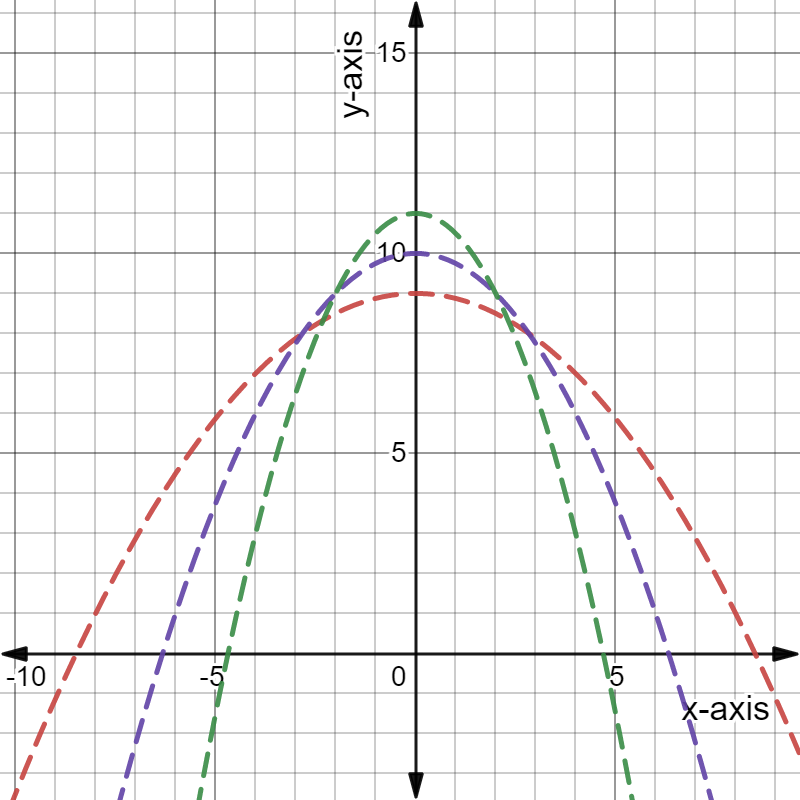
Page 164 Problem 2 Answer
The path of football goes up, creates an downward U shape and come back.
The distance and shape of path covered before and after the maximum height remains same for the football.
The shape of the path covered by football is known as a parabola.
The path of a projectile under the influence of gravity follows a curve of this shape.
The shape created by path of football is a parabola.
Read and Learn More Precalculus Textbook Mcgraw Hill Answers
Page 164 Problem 3 Answer
The maximum and minimum height is the value on y-axis, where x=0
Hence, the height of graph is the constant term c in equation y=ax2+bx+c
The maximum or minimum height is the distance covered on y-axis where x=0
Hence, the height is the constant term c of equation y=ax2+bx+c
Page 168 Problem 4 Answer
The given quadratic function is y=x2+6x+5.
Let, f(x)=x2+6x+5.
Here, the coefficient of x2 is positive.
So, the parabola is open upward.
From the given function, a=1,b=6,c=5.
Therefore, the x-coordinate of the vertex is 6/2=3.
Substitute x=3 in f(x).
f(x)=x2+6x+5
f(3)=32+6(3)+5
f(3)=9+18+5
f(3)=32
Therefore, the co-ordinate of the vertex is (3,32).
The minimum value is the y-coordinate of the vertex.
Therefore, the minimum value is -4.
The equation of the axis of symmetry is x=−b/2a.
Therefore, the axis of symmetry is x=−3.
Substitute x=0 in y=x2+6x+5 yields y=5.
Substitute y=0 in y=x2+6x+5.
x2+6x+5=0
x2+x+5x+5=0
(x+5)(x+1)=0
Therefore x-intercepts are x=−5,−1.
Domain: All real numbers.
Range: 7⩽y⩽∞.
The required properties of the quadratic functions are,
The parabola is open upward.
Therefore, the co-ordinate of the vertex is (3,32).
Therefore, the minimum value is -4.
Therefore, the axis of symmetry is x=−3.
Therefore x-intercepts are x=−5,−1.
Domain: All real numbers.
Range: 7⩽y⩽∞.
Mcgraw-Hill Textbook Answers
Page 168 Problem 5 Answer
The given quadratic function is y=−x2+2x+3.
Let f(x)=−x2+2x+3
Here, the coefficient of x2 is negative.
So, the parabola is open downward.
From the given function, a=−1,b=2,c=3.
Therefore, the x-coordinate of the vertex is −2/−2=1.
Substitute x=1 in f(x).
f(x)=−x2+2x+3
f(1)=−(1)2+2(1)+3
f(1)=−1+2+3
f(1)=4
Therefore, the co-ordinate of the vertex is (1,4)
The maximum value is the y-coordinate of the vertex.
Therefore, the maximum value is 4.
The equation of the axis of symmetry is x=−b/2a
Therefore, the axis of symmetry is x=1
Substitute x=0 in y=−x2+2x+3 yields y=3.
Substitute y=0 in y=−x2+2x+3.
−x2+2x+3=0
x2−2x−3=0
x2−3x+x−3=0
(x−3)(x+1)=0
x=3,−1.
Therefore x-intercepts are x=3,−1
Domain: All real numbers.
Range: −∞⩽y⩽4
Mcgraw-Hill Textbook Answers
The required properties of the quadratic functions are,
The parabola is open downward.
The co-ordinate of the vertex is (1,4).
The maximum value is 4.
The axis of symmetry is x=1.
Therefore x-intercepts are x=3,−1.
Domain: All real numbers.
Range: −∞⩽y⩽4
Page 172 Problem 6 Answer
Given: There is 160 m of rope available to create the perimeter.
To write a quadratic function in standard form to represent the area for the stroller parking.
Simply do some algebraic operations.
The perimeter is 160 m.
P=2(L+W)
160=2(L+W)
80=L+W
W=80−L
The required area is:
A=L⋅W
A=L(80−L)
A=80L−L2
Hence, the required quadratic equation is A=−L2+80L.
Mcgraw-Hill Textbook Answers
Page 172 Problem 7 Answer
Given: There is a 160 m of rope available to create the perimeter.
What are the coordinates of the vertex? What does the vertex represent in this?
Simply use a graphing utility to graph the function.
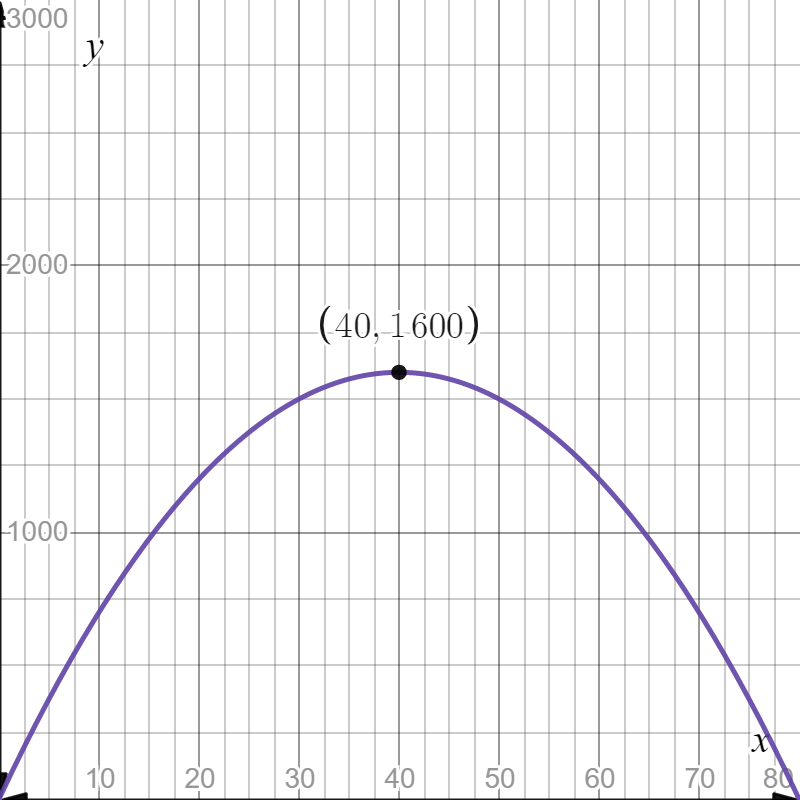
The required quadratic function is A=−L2+80L.
The required vertex is (40,1600).
The vertex means the maximum area of 1600m2 occurs when the length is 40 m.
Hence, the required coordinate of the vertex is (40,1600) and the vertex means that the maximum area is 1600m2 occurs when the length is 40 m.
The required graph is:
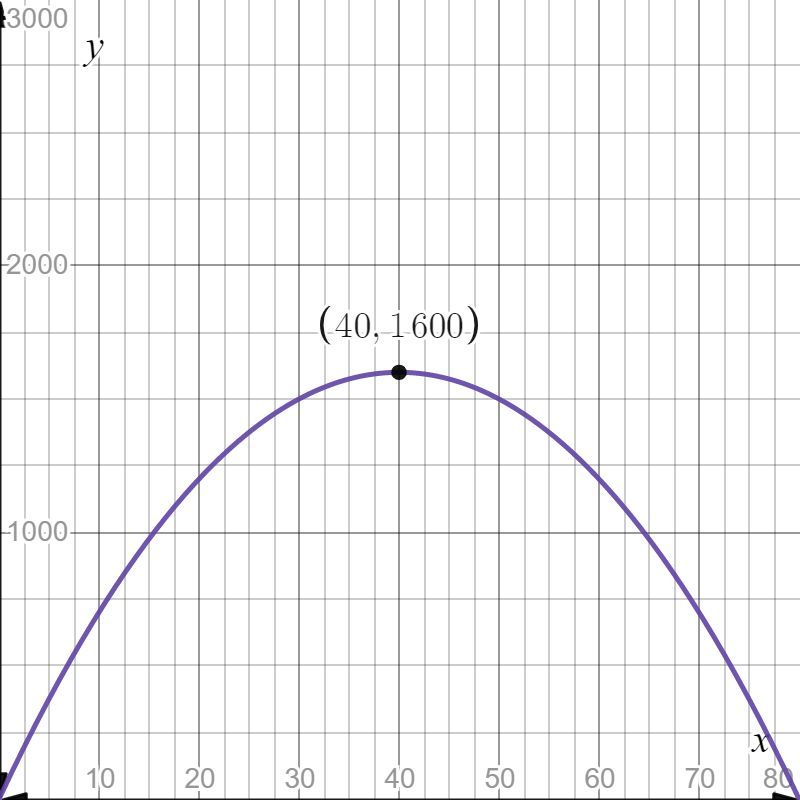
Page 172 Problem 8 Answer
To sketch the graph for the function in part (a).
The required quadratic equation is A=−L2+80L.
Simply use a graphing calculator to sketch the graph.
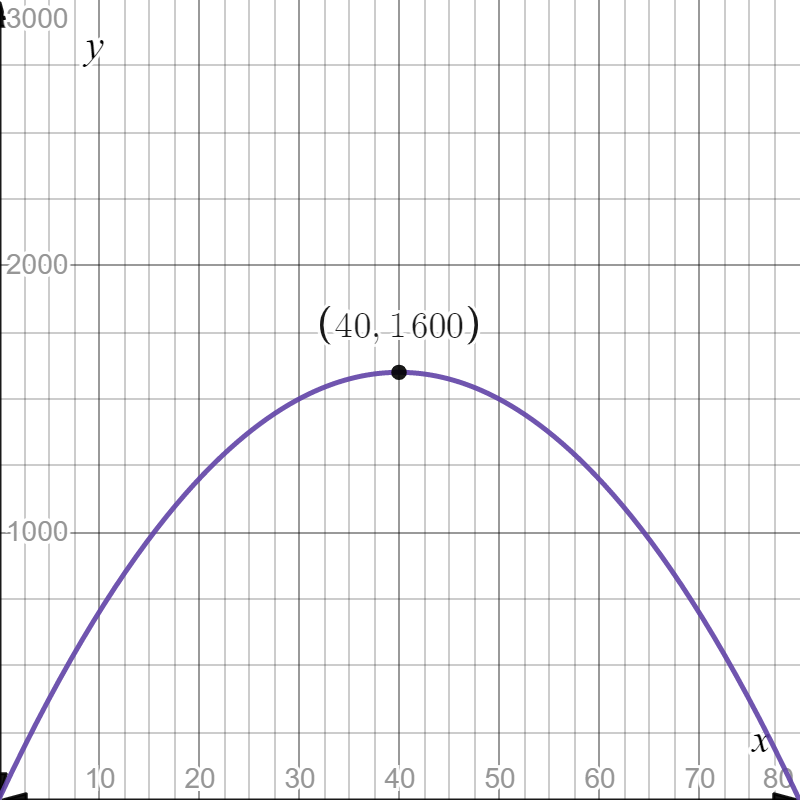
The required graph of the quadratic equation A=−L2+80L is:
Hence, the required sketch is:

Page 172 Problem 9 Answer
To determine the domain and range for this situation.
The quadratic equation is A=−L2+80L.
To sketch the graph of the quadratic equation.
The required sketch is:

The required domain is 0<L<80 and the required range is 0<A≤1600.
Hence, the required domain is 0<L<80 and the required range is 0<A≤1600.
Page 172 Problem 10 Answer
The quadratic function written in part a) A=−L2+80L
The equation is written by assuming that perimeter of rectangle is 160m that means the organizers will use all of the rope to make the stroller parking.
L+W=80
Mcgraw Hill Precalculus Textbook Answers
Length and width cannot be negative.
So, it also assumes that any width or length from 0 m to 80 m is possible.
In reality, there may be other limitations on the dimensions of the stroller parking, such as the available area and landscape of the location of children’s music festival.
The quadratic function written in part a) assumes that the organizers will use all of the rope to make the stroller parking.
It also assumes that any width or length from 0 m to 80 m is possible.
In reality, there may be other limitations on the dimensions of the stroller parking, such as the available area and landscape of the location of children’s music festival.
Page 174 Problem 11 Answer
a)f(x)=2×2+3x
This is a polynomial with degree 2
So, function a)f(x)=2x2+3x is a quadratic function.
d)f(x)=(2x−5)(3x−2)
f(x)=6x2−15x−4x+10
f(x)=6x2−19x+10
This is a polynomial with degree 2
So, function d)f(x)=(2x−5)(3x−2) is a quadratic function.
b)f(x)=5−3x
This is a polynomial with degree1
So, function b)f(x)=5−3x is not a quadratic function.
c)f(x)=x(x+2)(4x−1)
f(x)=x(4x2+8x−x−2)
f(x)=x(4x2+7x−2)
f(x)=4x3+7x2−2x
This is a polynomial with degree 3
So, function c)f(x)=x(x+2)(4x−1) is a quadratic function.
The following functions are quadratic:
a)f(x)=2x2+3x
d)f(x)=(2x−5)(3x−2)
Page 174 Problem 12 Answer
Given:
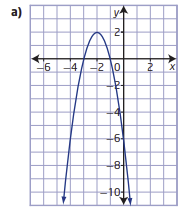
To find:
the coordinates of the vertex
the equation of the axis of symmetry
the x-intercepts and y-intercept
the maximum or minimum value and how it is related to the direction of opening
the domain and range
Graph:
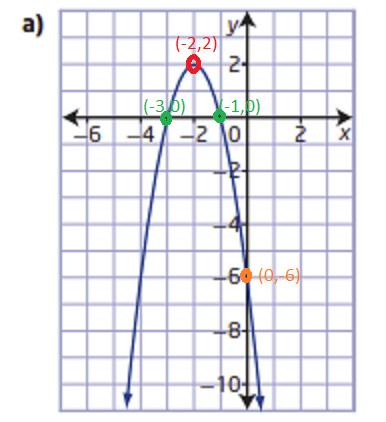
The coordinates of the vertex:
(h,k)=(−2,2)
The equation of the axis of symmetry
x=h
x=−2
The x-intercepts The graph intersects x−axis at (−3,0),(−1,0)
The y-intercepts The graph intersects y−axis at (0,−6) the maximum or minimum value and how it is related to the direction of opening
Opens downward: Maximum value at vertex
Maximum value of y=2 at x=−2
The domain : All real numbers, or {x∣x∈R}
The Range: All real numbers less than or equal to 2, or {y∣y≤2,y∈R}
The coordinates of the vertex: (−2,2)
The equation of the axis of symmetry: x=−2
The x-intercepts occur at (−3,0),(−1,0) and have values of −3 and −1
The y-intercept occurs at (0,−6) and has value of −6
The maximum value of y=2 at x=−2
The domain: All real numbers, or {x∣x∈R}
The Range: All real numbers less than or equal to 2, or {y∣y≤2,y∈R}
Mcgraw Hill Precalculus Textbook Answers
Page 174 Problem 13 Answer
Given: graph
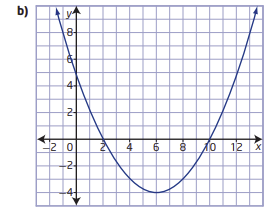
To find:
the coordinates of the vertex
the equation of the axis of symmetry
the x-intercepts and y-intercept
the maximum or minimum value and how it is related to the direction of opening
the domain and range
Graph

The coordinates of the vertex:(h,k)=(6,−4)
The equation of the axis of symmetry
x=h
x=6
The x-intercepts
The graph intersects x−axis at (2,0),(10,0)
The y-intercepts The graph intersects y−axis at (0,5)
the maximum or minimum value and how it is related to the direction of opening
Opens upward: Minimum value at vertex Minimum value of y=−4 at x=6
The domain : All real numbers, or {x∣x∈R}
The Range: All real numbers greater than or equal to −4, or {y∣y≥−4,y∈R}
The coordinates of the vertex: (6,−4)
The equation of the axis of symmetry:x=6
The x-intercepts occur at (2,0),(10,0) and have values of 2 and 10
The y-intercept occurs at (0,5) and has value of 5
The minimum value of y=−4 at x=6
The domain: All real numbers, or {x∣x∈R}
The Range: All real numbers greater than or equal to −4, or {y∣y≥−4,y∈R}
Mcgraw Hill Precalculus Textbook Answers
Page 174 Problem 14 Answer
Given: graph
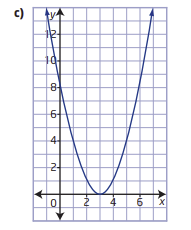
To find:
the coordinates of the vertex
the equation of the axis of symmetry
the x-intercepts and y-intercept
the maximum or minimum value and how it is related to the direction of opening
the domain and range
Graph

The coordinates of the vertex:(h,k)=(3,0)
The equation of the axis of symmetryx=h x=3
The x-intercepts The graph intersects x−axis at (3,0)
The y-intercepts The graph intersects y−axis at (0,8)
the maximum or minimum value and how it is related to the direction of opening
Opens upward: Minimum value at vertex
Minimum value of y=0 at x=3
The domain : All real numbers, or {x∣x∈R}
The Range: All real numbers greater than or equal to 0, or {y∣y≥0,y∈R}
The coordinates of the vertex:(3,0)
The equation of the axis of symmetry: x=3
The x-intercept occurs at(3,0)and has value of3
The y-intercept occurs at (0,8) and has value of 8
The minimum value ofy=0 at x=3
The domain: All real numbers, or {x∣x∈R}
The Range: All real numbers greater than or equal to 0, or {y∣y≥0,y∈R}
Page 174 Problem 15 Answer
Given: f(x)=5x(10−2x)
To show: Each function fits the definition of a quadratic function by writing it in standard form
f(x)=5x(10−2x)
f(x)=50x−10x2 : Distribute
f(x)=−10x2+50x+0 : Rearrange
The equation is in standard quadratic form which is a polynomial with degree two.
As such, the function fits the definition of a quadratic function.
In standard form, f(x)=−10x2+50x
The function is given by a polynomial of degree two.
Hence, the function fits the definition of a quadratic function.
Mcgraw Hill Precalculus Textbook Answers
Page 174 Problem 16 Answer
Given: f(x)=(10−3x)(4−5x)
To write: the quadratic function in the standard form.
(10−3x)(4−5x)
=10⋅4+10(−5x)−3x⋅4−3x(−5x)
=40−50x−12x−15x2
=15x2−62x+40
Complete the square:
15(x2−62x/15+8/3)
=15(x2−62x/15+8/3+(−31/15)2−(−31/15)2)
=15((x−31/15)2+8/3−(−31/15)2)
=15(x−31/15)2−361/15
The standard quadratic form is 15(x−31/15)2−361/15
Page 174 Problem 17 Answer
Given: y=3x2+7x−6
To find: with the help of the graph the vertex, the axis of symmetry, the direction of opening, the maximum or minimum value, the domain and range, and any intercepts
Draw the graph:
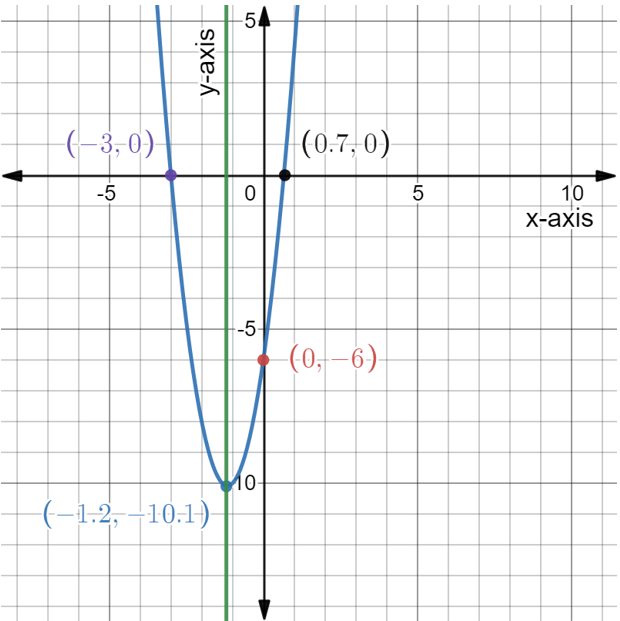
vertex-(−1.2,−10.1) the axis of symmetry-x=−1.2
the direction of opening-concave upwards the maximum- Not defined
The minimum value-−10.1 the domain-All real numbers
The range-[−10.1,∞)
x− intercept-−3,0.7
y−intercept-−6
vertex-(−1.2,−10.1)
the axis of symmetry-x=−1.2
the direction of opening-concave upwards the maximum- −10.1
The minimum value-not defined the domain-all real numbersThe range-[−10.1,∞)
Mcgraw Hill Precalculus Textbook Answers
Page 174 Problem 18 Answer
The given equation is y=−2x2+5x+3.
To graph the given equation using graphing utility and then find the vertex, the axis of symmetry, the direction of opening, the maximum or minimum value, the domain and range, and any intercepts.
By using the graphing utility, the graph of the given function is shown below:

The parabola crosses the yaxis at point (0,3) and crosses the x axis at point (−0.5 , 0) and (3 , 0).
Compare the given quadratic equation general quadratic equation, we get
a=−2, b=5 and c=3
Here, a is negative, so the parabola has a maximum.
The maximum value of parabola is 6.125≈6.1
From the above graph, it is observed that the parabola open downwards.
The domain of the quadratic function is any real number.
The domain of the given function is (−∞, ∞).
The parabola has a maximum, so the range of the given function is (−∞,6.1].
The axis of symmetry is x=1.3.
The graph is shown below:
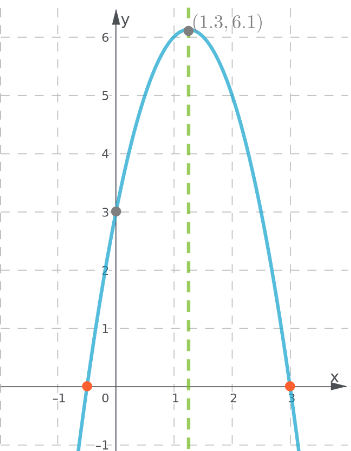
The vertex of y=−2x2+5x+3 is (1.3,6.1), the axis of symmetry is x=1.3, the graph opens downward, maximum value is 6.1, domain is −∞<x<∞, range is −∞<y≤6.1,x intercepts are at (−0.5,0) and (3,0),y-intercept is at (0,3).
Page 174 Problem 19 Answer
The given equation is y=50x−4x2.
To graph the given equation using graphing utility and then find the vertex, the axis of symmetry, the direction of opening, the maximum or minimum value, the domain and range, and any intercepts.
By using the graphing utility, the graph of the given function is shown below:
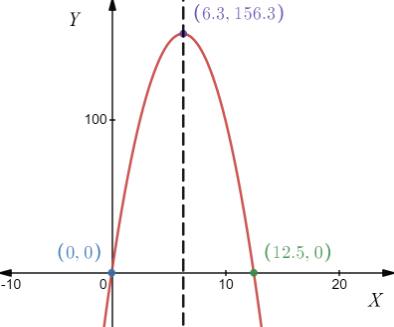
The parabola crosses the yaxis at point (0,0) and crosses the x axis at point (0 , 0) and (12.5 , 0).
Compare the given quadratic equation general quadratic equation, we get
a=−4, b=50 and c=0
Here, a is negative, so the parabola has a maximum.
The maximum value of parabola is ≈156.3
From the above graph, it is observed that the parabola open downwards.
The domain of the quadratic function is any real number.
Mcgraw Hill Precalculus Textbook Answers
The domain of the given function is (−∞, ∞).
The parabola has a maximum, so the range of the given function is (−∞,156.3].
The axis of symmetry is x≈6.3.
The graph is shown below:
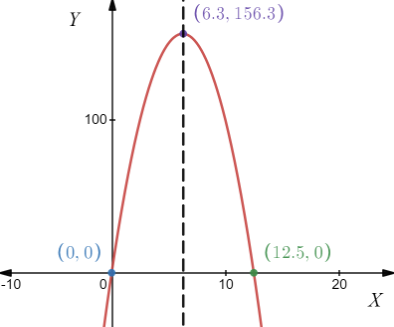
The vertex of y=50x−4x2 is (6.3,156.3), the axis of symmetry is x=6.3, the graph opens downward, maximum value is 156.3, domain is −∞<x<∞, range is −∞<y≤156.3,x intercepts are at (0,0) and (12.5,0),y-intercept is at (0,0).
Page 174 Problem 20 Answer
The given equation is y=1.2x2+7.7x+24.3.
To graph the given equation using graphing utility and then find the vertex, the axis of symmetry, the direction of opening, the maximum or minimum value, the domain and range, and any intercepts.
The parabola crosses the yaxis at point (0,24.3) and doesn’t cross the x axis.
Compare the given quadratic equation general quadratic equation, we get
a=1.2, b=7.7 and c=24.3
Here, a is positive, so the parabola has a minimum.
The minimum value of parabola is ≈12.0
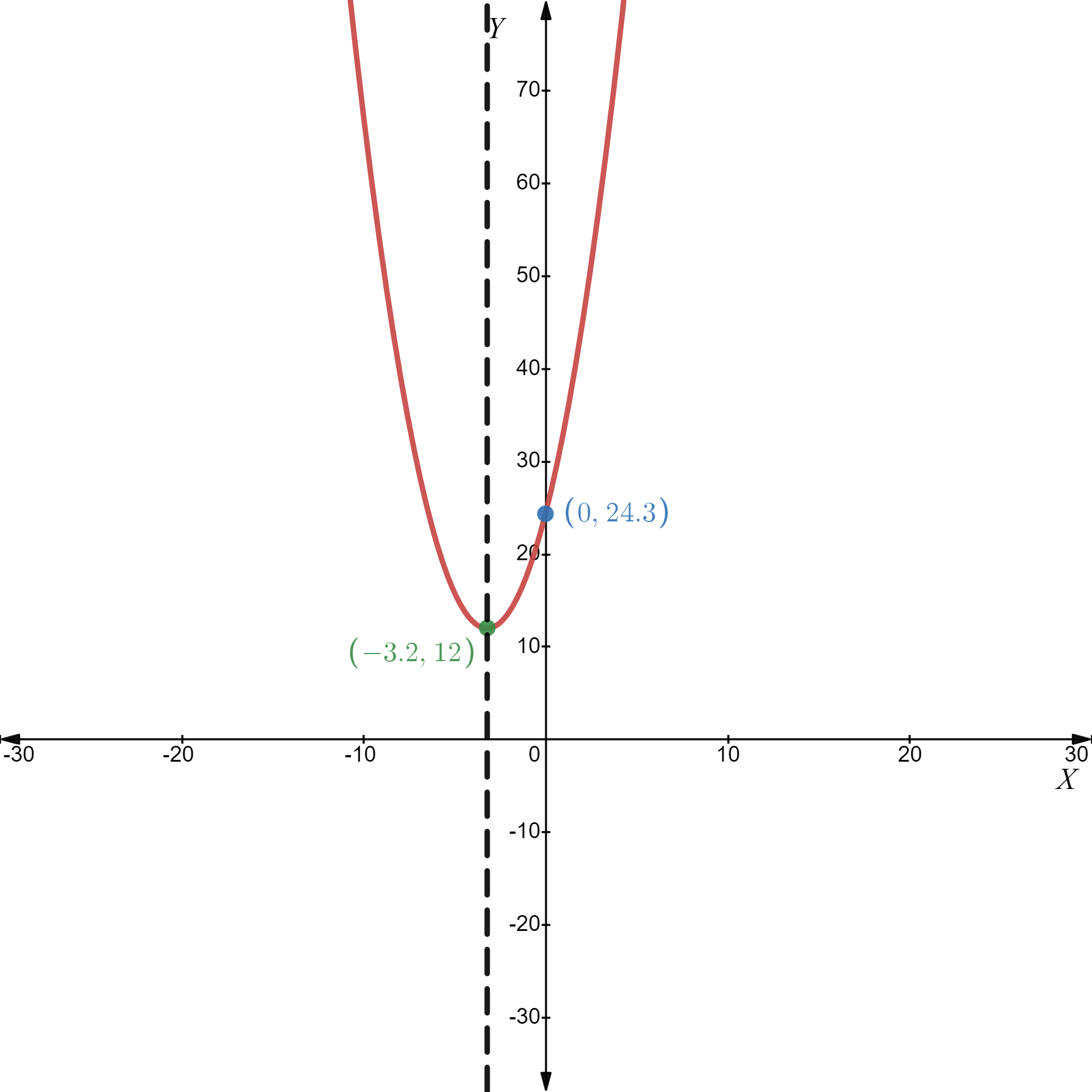
From the above graph, it is observed that the parabola opens upwards.
The domain of the quadratic function is any real number.
The domain of the given function is (−∞, ∞).
The parabola has a maximum, so the range of the given function is [12.0,∞).
The axis of symmetry is x≈−3.2.
By using the graphing utility, the graph of the given function is shown below:
The vertex of y=1.2x2+7.7x+24.3 is (−3.2,12), the axis of symmetry is x=−3.2, the graph opens upward, minimum value is 12, domain is −∞<x<∞, range is 12≤y≤∞, no x-intercepts and y-intercept is at (0,24.3).
The graph is shown below:
